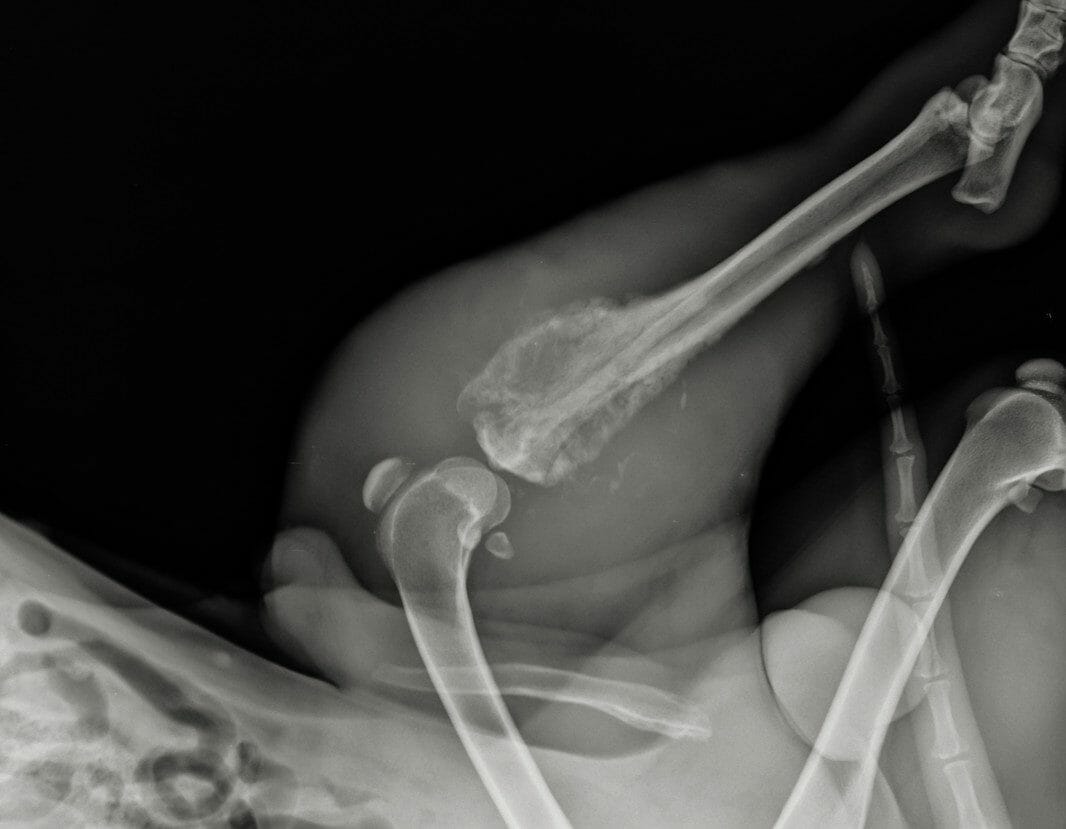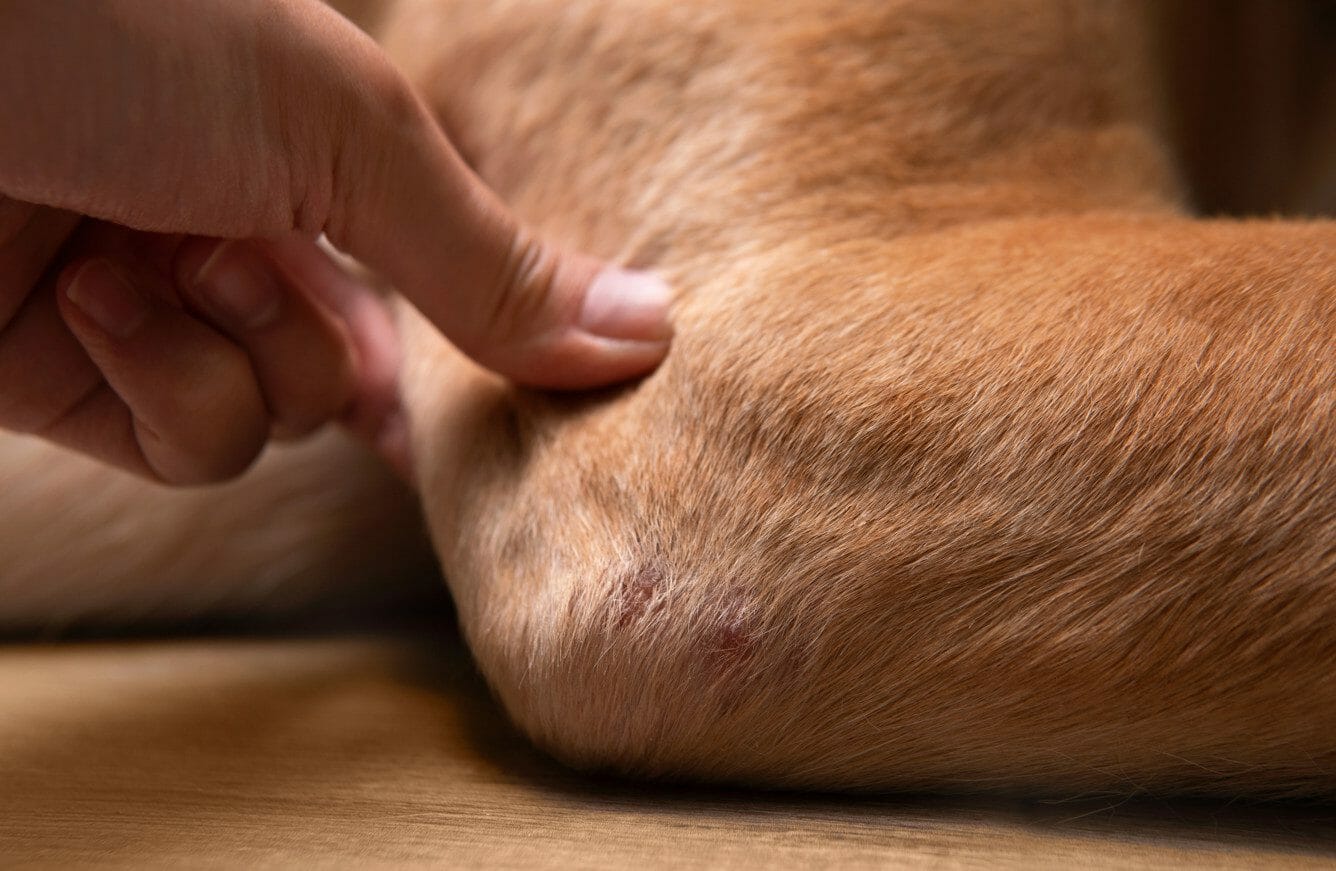What Is Osteosarcoma in Dogs?
Osteosarcoma in dogs is an aggressive and painful malignant tumor that affects a canine’s bones. This form of cancer arises from the abnormal production of cells called osteoblasts and osteoclasts. These cells are responsible for the creation and breakdown of bones. This condition leads to bones breaking. When this occurs, it is known as a pathological fracture.
The condition most commonly affects large and giant breeds of dogs and is typically found in the long bones of a dog’s limbs. However, osteosarcoma can also affect the pelvis, hips, and jaw. Extraskeletal osteosarcoma can also spread to non-bony tissue such as the spleen, kidney, and liver.

Causes of Osteosarcoma in Dogs
No definitive cause of osteosarcoma has ever been discovered. However, it is believed that the genes responsible for the promotion and suppression of the growth of tumor cells play a part in the development of the condition. Osteosarcoma is more prevalent in certain canine breeds and typically affects dogs that have reached middle age.
Signs of Osteosarcoma in Dogs
Osteosarcoma in dogs’ symptoms:
- Limping and lameness
- Swelling on the leg that is hard and hot to touch
- Sudden and unexplained fractured leg
- Lethargy
- Lumps and swelling elsewhere on the body
- High temperature
- Neurological signs include seizures and poor balance

Dog Breeds Prone to Osteosarcoma
Many large and giant breeds of dogs (listed below) are at a higher risk of developing osteosarcoma. As such, owners of these breeds should monitor their pets for the early warning signs of osteosarcoma and should visit a veterinarian as soon as any of the symptoms present.
- Boxers
- Doberman Pinschers
- German Shepherds
- Golden Retrievers
- Great Danes
- Great Pyrenees
- Greyhounds
- Irish Setters
- Irish Wolfhounds
- Labrador Retrievers
- Rottweilers
- Saint Bernards
- Weimaraners

Osteosarcoma in Dogs Diagnosis
To diagnose osteosarcoma in dogs, a veterinarian will usually carry out the following tests.
- X-Ray: An initial X-ray will be used to rule out any other potential reasons for lameness
- Biopsies: Areas identified as being problematic will be biopsied
- Urinalysis: Analysis of the urine will assess the general health of the dog
- Blood Test: To further assess the health of the dog, blood work will be taken
- Needle Aspirate: A large-bore needle will be inserted into the tumor so that the cells can be analyzed
- Chest X-Rays: Chest X-rays will be taken to assess whether the cancer has metastasized to the lungs
- CT Scan: Advanced CT imaging will identify the presence and extent of osteosarcoma tumors. This assessment will help determine whether surgery will be possible and if a favorable outcome can be achieved.

Osteosarcoma in Dogs Treatment
Osteosarcoma is an aggressive form of bone cancer that is usually assumed to have spread before detection. One of the first options that will be explored is amputation. Although amputating a limb can be very debilitating to a human, dogs typically function well using just three legs. Amputation surgery will usually be followed up with chemotherapy.
In some cases, it may be possible for the surgeon to perform limb-sparing surgery by performing a bone graft or bone transport osteogenesis to regrow the bone. The ability to perform this surgery will depend on the size and location of the tumor. Typically, this type of procedure can only be carried out if the cancer is diagnosed early. However, limb-saving surgery carries a higher risk of surgical complications and infection.
If surgery is not a viable option, stereotactic radiation (SRS/SRT) may help. This uses a high dose of radiation to kill any osteosarcoma cells. This precision treatment requires fewer sessions than other treatments, such as conventional fractionated radiation therapy (CFRT).
Bisphosphonates are a type of drug that is used in humans with bone tumors. These drugs have also proven to be useful in managing pain in dogs. These drugs inhibit the destruction of the bone, which also helps to ease pain. Pamidronate is the most commonly used bisphosphonate in dogs. However, zoledronate is becoming increasingly popular. The drugs are administered via an IV drip for two hours every three to four weeks. Bisphosphonates are used in dogs that have not undergone limb amputation.
Several analgesic medications are available for dogs with osteosarcoma. However, none are ideal for the level of pain that the dog will experience. Therefore, to provide a reasonable standard of palliative care, a combination of drugs will be needed. These drugs should only be administered as a last resort if radiation therapy and amputation cannot be pursued. These medications include:
- Non-steroidal anti-inflammatory drugs (NSAIDs). These will be administered in tablet form twice daily. The dog needs to have good kidney and liver function to be given this type of medication.
- Narcotic pain relievers. This type of medication will help with chronic pain and will not have any negative interactions with other pain medications.
- Miscellaneous supplemental pain relievers. Gabapentin and amantadine are two effective pain relievers for dogs that are experiencing chronic pain. Gabapentin is used for neurologic pain, and amantadine works with wind up, which occurs when nerves experience pain from stimuli that would not ordinarily lead to pain.

How to Prevent Osteosarcoma in Dogs
Preventing cancer is not possible in dogs. However, owners can work to reduce exposure to environmental factors that may contribute to its development. This means not smoking cigarettes around the dog, avoiding exposure to dangerous toxins, and minimizing the length of time the dog spends in direct sunlight.
Osteosarcoma in Dogs Prognosis
Osteosarcoma in dog’s life expectancy varies depending on the severity, spread, and treatment option provided. Dogs that receive chemotherapy and SRS/SRT can expect to live for around a year. The prognosis is similar for 90% of dogs that undergo chemotherapy and have a limb amputated. The remaining 10% can expect to live longer.
If just the limb is amputated without chemotherapy, life expectancy drops to just four months. If no limb is amputated and the dog does not undergo chemotherapy, the maximum life expectancy drops to three months.
Osteosarcoma can cause considerable pain and discomfort to a dog, so throughout the final months, palliative care will be required.



